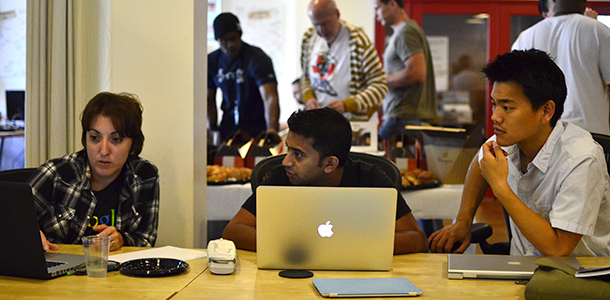
(Photo Credit: Phillipe Lewicki/Flickr)
Chris Benner, Ph.D., is a professor of Environmental Studies and Sociology at the University of California, Santa Cruz. He has been studying and writing on the issue of economic insecurity. Millions of Californians live in or near poverty and understand the issue in a very personal way. California Forward and the California Economic Summit have launched Elevate CA—a discussion about what California can do to improve upward mobility in our state. Benner argues that California's diversity is a strength that offers opportunity for new leadership in business and business groups.
The sharp rise in inequality in the U.S. – higher now than at any time since the Gilded Age– has given rise to populist movements on the left and right that cast blame on elites and a “rigged” economic system. And despite eight years of economic growth and near full employment, the average person’s sense of job insecurity remains high, especially in the context of uncertain impacts of rapid technological change.
For many, this insecurity is intensified by the demographic changes that will make the U.S. ‘majority minority’ sometime after 2040. While the increasing diversity is welcomed by many, others are frightened by a sense of cultural loss. Addressing these challenges would be easier if all actors were able to agree on a basic set of facts and so devise evidence-based solutions to the problems we face. Unfortunately, just as our crises have hit fever-pitch, we have also hit a new zenith in the fragmentation of knowledge: while Americans in the 1960s tended to glean their information from “broadcast news,” we are now fully in a “narrow-cast” world in which cable television channels appeal to certain audiences (and disdain others) even as many of us rely on our curated Facebook or Twitter echo chamber to deliver analysis with which we already largely agree. Unchallenged by opposing perspectives, we are increasingly drifting apart at exactly the moment in which we need to know and grow together.
In a recent research project, supported by the Association of Chamber of Commerce Executives, Manuel Pastor and I examined these broad trends and what they mean for chambers of commerce and similar place-based private sector led economic development organizations across the U.S. The findings have potential implications for California. We face similar experiences of inequality and insecurity, and even demographically, outside of the Coastal metropolitan areas and Sacramento, the demographics of the rest of California are quite similar to the country as a whole. The fragmentation of knowledge in different communities is as deeply entrenched in California as anywhere.
Our research unearthed some intriguing new statistics related to diversity and entrepreneurship. For example, the number of non-Hispanic white-owned businesses across the country is declining, while the number of businesses owned by people of color is growing. Between 2007 and 2012, the number of African American-owned businesses grew 46.3 percent, Latino-owned business grew by 34.5 percent, Asian-owned businesses grew by 23.8 percent, while non-Hispanic white owned businesses declined by 8 percent. Similarly, the number of businesses owned by immigrants is also growing. A quarter of all new businesses in the country are started by immigrants. Immigrants now represent 18.4 percent of the self-employed population. In a detailed study of businesses in 11 states, immigrant entrepreneurship rose from a 17 percent share to a 27 percent share, while immigrant-owned businesses represented 30 percent of all businesses receiving venture capital funding, and businesses started by immigrant entrepreneurs had higher levels of employment growth than native-founded businesses.
Our report also examines the implications of these trends for local and metropolitan chambers of commerce. As place-based actors with a perceived commitment to place and often a high level of community trust, chambers can and should play a broader civic role at helping Americans make their way through these dramatic shifts. After all, business leaders can see the opportunity change brings and they increasingly recognize that there is a strong economic case for embracing not rejecting our growing diversity.
Some places are leading the way, offering lessons for others to follow. In San Antonio, Texas, decades of discord between business and community have been replaced by striking instances of collaboration, particularly around supporting pre-K for less advantaged kids – with the business case being that this is part of preparing the workforce for the mid-century. In Jacksonville, Florida, a long-established Community Council has been bringing together actors across sectors to devise solutions to the region’s pressing problems; younger business leaders have consistently been part, building bridges across the region that allow for quick and effective responses. In metros as conservative as Salt Lake, as liberal as Seattle, and as straight down the middle as Raleigh, North Carolina, we find a commitment to planning processes that bring multiple actors together to embrace their shared fate and find real solutions to problems as vexing as homelessness, poverty, immigration, and the environment; in all these cases, business leadership has played a key role.
While we highlight these and other promising and inspiring practices of chambers across the country that are learning to embrace inclusion, we also stress how much more needs to be done. Getting there will require understanding the role of business leaders not just as economic agents but as civic leaders, often in partnership with groups with which they may have been at odds in the past. We stress that local chambers may be uniquely suited to generate this new sort of leadership, partly because they are more rooted in local areas, more likely to be a vehicle for building relationships, and perhaps more able to steer civic conversations away from partisan ideology and toward a data-driven analysis of the possibilities.
 But stepping up to this role will mean taking diverse leadership development efforts seriously as well as understanding the role of chambers in providing broad civic fabric. Fortunately, there is much to build on but we stress that this is not for the faint-of-heart: a bumpy process is to be expected as making adjustments to accommodate our inevitable demographic and economic changes is not easy, and can involve substantial conflict. However, those chambers who don’t embrace the growing diversity of American society are likely to see themselves increasingly marginalized economically and socially, while those that embrace it are not only likely to be more successful, but can play a critical role in helping smooth our path to a more prosperous and interconnected America.
But stepping up to this role will mean taking diverse leadership development efforts seriously as well as understanding the role of chambers in providing broad civic fabric. Fortunately, there is much to build on but we stress that this is not for the faint-of-heart: a bumpy process is to be expected as making adjustments to accommodate our inevitable demographic and economic changes is not easy, and can involve substantial conflict. However, those chambers who don’t embrace the growing diversity of American society are likely to see themselves increasingly marginalized economically and socially, while those that embrace it are not only likely to be more successful, but can play a critical role in helping smooth our path to a more prosperous and interconnected America.

